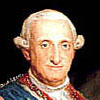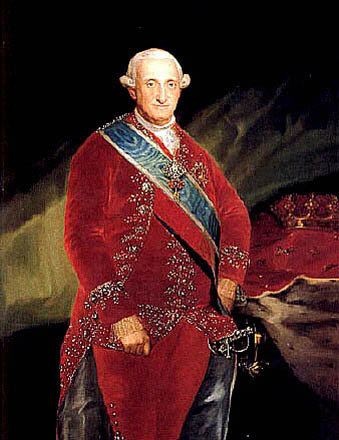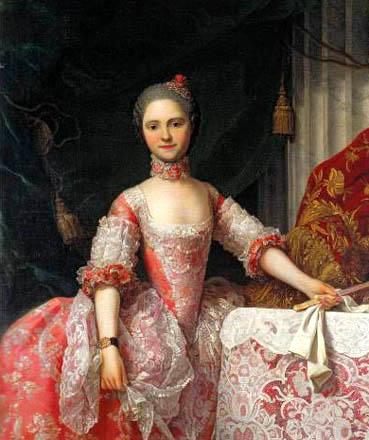Meadows Museum presents 'Royal Splendor in the Enlightenment'
Meadows Museum presents the exceptional art collection and refined taste of King Charles IV of Spain.

DALLAS (SMU) —The Meadows Museum at Southern Methodist University is presenting Royal Splendor in the Enlightenment: Charles IV of Spain, Patron and Collector, the first major exhibition to showcase the exceptional art collection and refined taste of King Charles IV of Spain (1748-1819), from March 7 through July 18, 2010.
Mark Roglán talks with WFAA's Good Morning Texas |
The Meadows Museum is the only venue outside of Spain for the exhibition, the result of a unique collaboration between the museum and Patrimonio Nacional, the Spanish government institution that manages the artistic holdings created through the patronage and sponsorship of the Spanish monarchs.
The exhibition is curated by Patrimonio Nacional curators Dr. Javier Jordán de Urríes y de la Colina and Dr. José Luis Sancho.
Charles IV and his wife, Queen María Luisa, reigned from 1788 to 1808 (when they were forced into exile by Napoleon), at the end of the Enlightenment period. They had a special passion for the arts and collected avidly throughout their lives.
“During his reign, Charles IV created a highly sophisticated, refined and cosmopolitan court for which the arts played a major role,” said Dr. Mark Roglán, museum director.
“The combination of collecting works from the past as well as investing in those of the present, especially in the field of decorative arts, became part of the daily life of this king, whose artistic taste was among the finest in his time and in the history of the Spanish monarchy,” Roglán continued. “The exhibition also shows the development of Charles’ artistic interests; he was not only influenced by the Spanish tradition, but had a special fondness for Italian art because of his childhood origins in Naples, and for French art, due to the dense network of dynastic relations that linked the Bourbons of Versailles to those of Madrid in the 18th century.”
The exhibition includes more than 80 examples of furniture, textiles, clocks, porcelains, paintings and sculptures selected from the casas de campo (country estates) and royal palaces of Madrid, Aranjuez, El Escorial and El Pardo. The majority of works are from Patrimonio Nacional (the Spanish National Heritage), and most of them have never before traveled to the U.S. The collection includes some of the finest examples of art styles of the day, from Rococo paintings to a stunning Neoclassical dessert centerpiece of semi-precious stones, lapis lazuli, gilded bronze and enamel.

The exhibition, which will be shown in the Jake and Nancy Hamon Galleries, will be accompanied by a scholarly, fully illustrated catalogue in English produced by the Meadows Museum. Also included will be a documentary that will feature, in HD video, the rooms and gardens of the palaces highlighted in the exhibition, bringing to life the splendid residences of the King.
Background
Charles IV, “King of Spain and Emperor of the Indies,” as he was officially known, was born in Portici (Naples) in 1748. He married his first cousin María Luisa de Borbón-Parma, a granddaughter of the French King Louis XV, in 1765, and became ruler on December 14, 1788, upon the death of his father, Charles III. In 1808 the king and queen were forced into exile by Napoleon. They eventually settled in Rome, where they died, just a few days apart, in 1819.
Thanks to the great administrative and economic reforms of his father, Spain was still one of the great world powers and enjoyed considerable prestige internationally when Charles IV ascended to the throne. As a result of its support for the cause of American independence, Spain had broadened its control over the greater part of the American continent, including extensive North American territories, in the area then known as the Viceroyalty of New Spain. (The complementary exhibition Contours of Empire: The World of Charles IV in the first floor galleries, featuring maps and books from SMU’s DeGolyer Library, will explore and analyze the territories that comprised the Spanish Empire during this period.)
Spain was also at the forefront of the Enlightenment during the 18th century. Throughout Europe, the enlightened monarchies, through their Royal Academies of the Arts, used works of architecture, sculpture, and painting to express their ideals of government and to develop new, more rational ideas in accordance with the prevalent neoclassical aesthetic. The new tastes and ideals of the Enlightenment were developed in both public monuments and palaces, where they could be seen and appreciated on a day-to-day basis by both the general public and the Crown. As a result, the arts became an instrument of propaganda and prestige. In this respect, the Spanish Crown became one of the most important courts of its time, especially during the reign of Charles IV.
The Spanish court moved about from season to season among several royal sites, including palaces and country estates with gardens and pavilions where Charles would spend part of the day relaxing and eating in the company of his most intimate circle. Charles took great pleasure in supervising the furnishing and decoration of his residences, which came to epitomize 18th-century opulence and fine artistic taste.

Furnishings from each of these residences are included in the exhibition, illustrating the great interest in classical antiquity that was prevalent throughout Europe at the time. Charles had a special passion for French decorative objects, especially works in silk, bronze, and porcelain, as well as pieces of furniture, and employed a number of artisans who had left Paris during the French Revolution seeking work in Spain. These works not only set a cosmopolitan tone inside the Spanish palaces and casas de campo, but also exerted a strong influence on the work of Spanish artists, thereby helping to bring the art of the court of Madrid into line with that of the rest of Europe. From artists such as the French designer Jean-Démosthène Dugourc and the Spanish architect Isidro Velázquez to silk manufacturers in Lyon, bronze smiths in Paris and Madrid, and woodworkers from the “Royal Workshop,” all contributed to the elaboration of a coherent collection of works that may now be seen outside of Spain for the first time.
This exhibition has been organized by the Meadows Museum and Patrimonio Nacional, and funded by a generous gift from The Meadows Foundation. Additional support has been provided by the Spanish Ministry of Culture, the Spain-USA Foundation, and the Embassy of Spain, Washington, D.C.
About the Patrimonio Nacional
Patrimonio Nacional oversees and safeguards an assemblage of emblematic palaces and monasteries spread throughout Spain, along with the 55,000 acres of parks that surround them. Patrimonio Nacional administers the wealth of the State on behalf of the Spanish Crown. It regularly serves as a venue for official ceremonies. Collectively, Patrimonio Nacional is one of Europe’s main cultural institutions, whose museums contain approximately 155,000 works of art. Its forests and gardens, which are open to the public, constitute a first-order landscaping and environmental benchmark, and a number of them are also World Heritage Sites.
About the Meadows Museum
The Meadows Museum, a division of SMU’s Meadows School of the Arts, houses one of the largest and most comprehensive collections of
Spanish art outside of Spain, with works dating from the 10th to the 21st century. It includes masterpieces by some of the world’s greatest painters: El Greco, Velázquez, Ribera, Murillo, Goya, Miró and Picasso.
The museum is located at 5900 Bishop Blvd. on the campus of SMU, three blocks west of the DART light rail Mockingbird Station. Hours are 10 a.m. to 5 p.m. Tuesday, Wednesday, Friday and Saturday; 10 a.m. to 8 p.m. Thursday; and 12-5 p.m. Sunday.
Admission is $8 per person, $6 for seniors, free on Thursday evenings after 5 p.m., and free for children under 12, museum members, and SMU faculty, staff and students. Ample free parking is available in the museum garage.
For information, call 214-768-2516 or visit www.meadowsmuseumdallas.org .
# # #